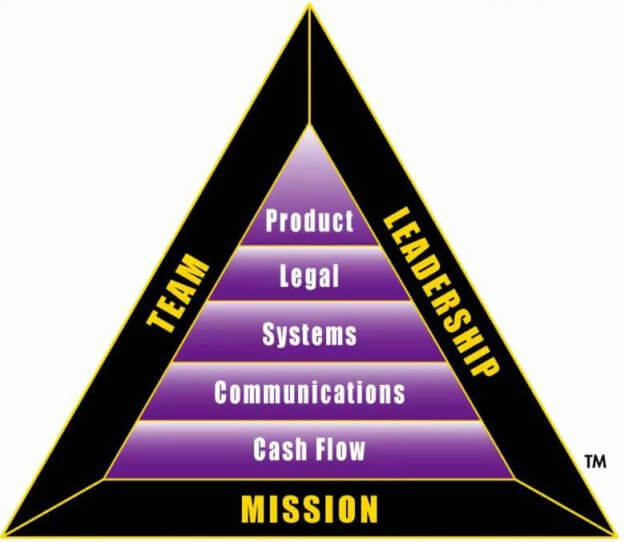Timing is everything when launching a new business or growing in additional directions. Business leaders benefit from using a quick tool for assessing whether now is the right time to make strategic changes. Where can one find such a tool to make a quick, accurate and impactful decisions? The answer is found in a simple tool espoused by Robert Kiyosaki: The B/I Triangle. It is a wonderful test that requires minimal input from each of your key contributors to make a solid assessment on moving forward. Robert Kiyosaki has stated for years that successful businesses have each of the components illustrated below.

Outside of the Triangle
The first thing you should notice is that it is a triangle. Yes, my father said that I was a bright child. I know you can see that. But what does that mean? First, if you take away any of the outside sections what happens to the triangle? It falls down! That means that if any one of the following areas (team, leadership and mission) is unstable or unclear in their roles, the whole structure is in jeopardy of failing. Think about it this way: If you have a great leader and a clear mission, but no team then your leader is going to fatigue very quickly. If you have a great team and a leader, but an unclear mission you end up with no direction. You get the picture.
Think about the organizations you’ve worked with or were a patron of:
- What did you think of their mission?
- Was it clearly written and well-known by the whole organization?
- How did that affect your view of the organization?
- Did each team members know their role?
- Was leadership strong in their management of the organization?
If all of these pieces are in place, then you have the foundations for a well-run organization that will remain strong for a long time to come. But that’s not all; there’s more to a company than just team, mission and leadership, right?
If we liken of the outside of the triangle to the outer walls of a building, the internal structure will also benefit from reliable support and give the whole organization a better chance to succeed.
- Mission – This should explain why you do business in both business and personal terms. It should be easy to understand for those that work for you and those that use your service or buy your product. When you write it, you’ll know that you are done when it “feels” right. If you still have questions or reservations on the statement, keep going.
- For those of you that say, “I need a little more,” I totally understand. This, despite the fluffy sounding nature of writing this, is HARD WORK. This article provides a great explanation of what a mission statement is and what it is not. The author states that a good mission statement is the WHY of the business that does three things:
- It defines what the company does for its customers
- It defines what the company does for its employees
- It defines what the company does for its owners
- For those of you that need more, read the whole article. It is the best explanation of a mission statement that I’ve seen. Follow the five-step plan. Pay close attention to step number five. By spending the time and doing this the right way you will clarify your company to you, your employees and your clients.
- For those of you that say, “I need a little more,” I totally understand. This, despite the fluffy sounding nature of writing this, is HARD WORK. This article provides a great explanation of what a mission statement is and what it is not. The author states that a good mission statement is the WHY of the business that does three things:
- Team – Each of the members should understand their portion of the business and how it contributes to fulfilling the overall mission.
- Leadership – The leader ensures that the team is focused on and moving towards the company’s mission. The leader also makes sure that everyone on the team knows their role and its value in achieving the company’s vision. It is important to recognize that the leader does not need to have all of the answers; they hire people who are experts in their respective areas so the leader can confidently turn to them for solutions when issues arise.
The Inside of the Triangle
With the outside structure solidly in place you are prepared to address the different floors of the building. From the bottom to the top they are: cashflow, communications, systems, legal and product. The importance of each component is signified by the amount of space it occupies within the triangle. Cashflow is king and occupies the most space in the triangle. Product occupies the least space and is the least important. “Wait a minute,” you say, “product is important.” I agree, but without the support of all of the other levels below it product becomes less relevant. I’ll give you an example.
How many of you have been to McDonald’s? All hands should go up, ven if you didn’t go willingly. I remember the peace of the McDonald’s playland while my then 2-year-old son raced around. But I digress. The McDonald’s burger, in my small survey sample, is not the best burger in the world. However, at last count there are over 37,241 locations around the world. How could that be? They are not the best burger in the world, right? Think of the best burger you’ve ever eaten and ask a simple question- why is there only one or just a handful? Chances are good that the answer will involve that the organization lacks in at least one of the areas in the B/I triangle. Here’s a little bit more to help you assess your organization, in order of importance
- Cashflow – Without cashflow to run your day-to-day operations your journey as a business will be a painfully short one. Think of cashflow as to a business as blood is to a body. No matter how good everything else is, without it, your business (or you) are done.
- Communications – Here we are referring to both internal and external communications. How do we communicate to our employees and suppliers? Is it clear? How do we communicate to our clients or prospective clients (better known as marketing)? Borrowing an example from McDonald’s, if I sang the jingle, “bah de bop be dah, I’m loving it,” would you know what the commercial was about? The simple answer is, yes. This is the function of making people aware of what product/service you have and how the business will deliver it to them.
- Systems – How we do things. In your organization, is everything an emergency, or are operations running relatively smoothly excepts a few fires. A simple look at your processes will answer that question. Frequent emergencies are an indicator that your operational processes need to be re-evaluated. The fewer emergencies, the clearer your processes are. In my years of coaching clients, I consistently see that almost all organizations have room for improvement, which can be accomplished relatively quickly. A “system” is a process that allows you to accomplish routine tasks. A look at your systems will almost assuredly reveal a routine task that each employee completes differently every time it’s done. Creating a standardized process will allow for new efficiencies, and new efficiencies will put more money in your pocket. Additionally, by defining your workflow you are better-equipped to onboard future new employees; this is an important skill for growth and scalability.
- Legal – Is your business’s “competitive advantage” or “secret to success” legally protected? If not, you may want to consider patents, trademarks, copyrights and a visit to your local intellectual property attorney. The cost of a good lawyer is far less than the cost of losing your competitive advantage. There is an urban legend that exemplifies this point. Rumor has it that years ago in Utah County there was a person with the last name of McDonald that had a burger stand. He decided to use the Golden Arches as his logo. That action met with swift and harsh litigation by McDonald’s. He stopped using the trademarked Golden Arches.
- Product – The actual product or service is last. Why is this? If you’ve been following the points mentioned above, then you understand that the product needs to fulfill a need that the market is willing to pay for. But is it the most important piece of the puzzle? NO! Utilizing our example from above we look at McDonald’s. McDonald’s is not the best burger. Is it consistent? Yes. Satisfying? Perhaps. Best burger? No way! However, it can be argued that the other sections of the BI triangle are expertly executed by the McDonald’s Corporations. That makes it so every time a new McDonald’s shows up, so do the customers. Notice also that the smallest amount of area taken up inside the triangle is the Product section.
There is an old saying, “If you build a better mousetrap the world will beat a path to your door.” Well, if you do that and execute on all of the sections of the B/I triangle you’ve got yourself a winner.




I I’m a young entrepreneur that is in the agriculture business and I’m using the BI triangle to structure my business the correct way. I just want to say thank for the clarification and information that you provided to us beginners we appreciate your help all ways. From Jamaica